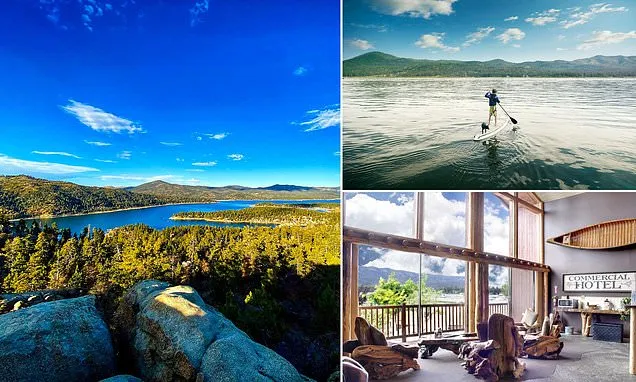Big Bear Lake, the alpine escape just two hours from Los Angeles, looks every bit like a retreat for billionaires.
But despite its stunning natural scenery and glossy holiday homes, it remains one of the most affordable lake towns in California.
While the likes of Lake Tahoe repeatedly hit the headlines for its sky-high cost of living, Big Bear is comparatively budget friendly.
Perched on the shoreline, the newly reimagined Hotel Marina Riviera has quickly become the design-forward darling of the lake town.
The 42-room boutique property has emerald tones, midcentury modern décor and even a barrel sauna overlooking the water—features more often associated with Aspen lodges than a budget-friendly mountain getaway.
Travel + Leisure has already given it early praise. Yet midweek lakeside rooms, with windows looking out over the San Bernardino National Forest, are listed at under $200 a night.
That price point is unheard of just 100 miles away in Los Angeles, where billionaires vacation in enclaves like Malibu, Lake Arrowhead or Tahoe.
In those destinations, millionaires and celebrities buy up whole stretches of shoreline, driving up costs for everyone else.
In Big Bear, the wealthy may own glassy mansions on private docks, but most of the town is made up of modest ranch homes, small cabins and diners serving $17 breakfast platters large enough to feed a family of four.
The average home in Big Bear Lake costs about $579,000, with a median income of $80,400—making it pricier than the national average but still more affordable than most California cities, according to Livability.com.
Visitors of all budgets share the same hiking trails, public beaches and panoramic views of the lake.
The mix of affluence and accessibility is visible on California's Rim of the World Highway, the ridge road leading into Big Bear.
Teslas and sleek sports cars weave past sun-faded vans weighed down with camping gear and minivans full of children.
Unlike Arrowhead, which is entirely private, Big Bear's 22 miles of shoreline remain open to the public—dotted with rental cottages, family-run lodges and hotels that cost a fraction of what similar properties command in Tahoe.
Big Bear has long been a magnet for visitors—from the Serrano people who lived along its streams for thousands of years, to 19th-century gold miners and loggers, to today's weekend skiers, hikers and boaters.
In recent years, developers have begun investing in new hotels and restaurants, including Sessions Retreat & Hotel, where midweek rooms still hover around $100, and De La Nonna, a hip pizza spot with a sister location in Los Angeles' Arts District.
The lake has been called the 'best in America' by USA Today, and the town now draws more than seven million visitors annually.
Developers are also pushing larger projects, such as the long-gestating 62-acre Moon Camp resort, raising concerns Big Bear could one day face the same elitism as Tahoe and Arrowhead.
Yet compared with other California hot spots, Big Bear has so far avoided the billionaire squeeze.
While neighboring Lake Arrowhead is ringed with French chateaus and Tahoe regularly battles over shoreline access with tech moguls like Mark Zuckerberg, Big Bear has remained an outlier: a scenic escape where the trappings of luxury are present but the price tag is still manageable.
